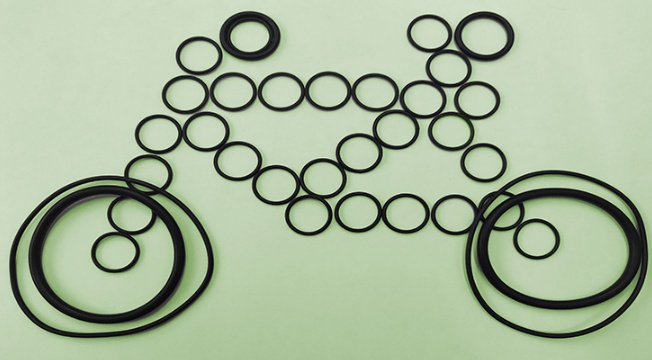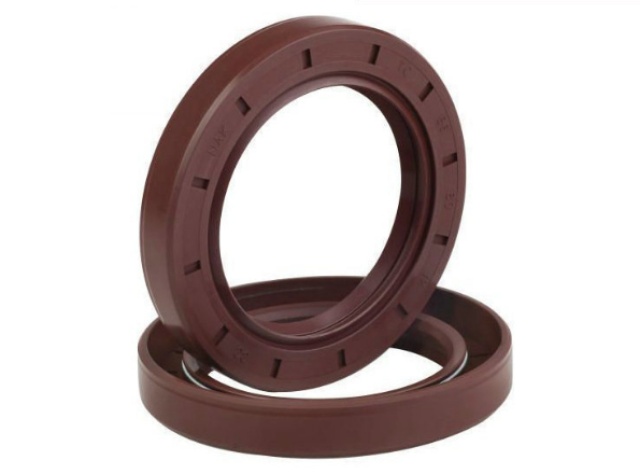The Chinese engine oil seal under Flexible operation chinese oil seal design is installed on the rotating shaft end of the operating device, which isolates the parts that need to be lubricated from the contributing parts in the transmission parts and prevents the leakage of lubricating oil. The following editor will introduce the function and structure diagram of oil seal classification? What material is good for the oil seal material?
تأثير تصنيف ختم الزيت والمخطط الهيكلي

A reliable chinese engine oil seal, also known as a crankshaft seal, is a small but important component of an engine. It is usually made of rubber or silicone and is designed to fit around the engine crankshaft. Its main function is to prevent oil from leaking from the engine crankshaft to the ground. Engine oil seals are essential because without them, the engine will lose oil, causing poor lubrication and potentially severe engine damage.
How do engine oil seals work
Engine oil seals work by creating a tight seal around the engine crankshaft. The seal is designed to fit snugly against the crankshaft, preventing oil from escaping. Most engine oil seals are designed with a spring lip that creates pressure on the crankshaft, ensuring a tight seal. The lip also helps scrape excess oil off the crankshaft as it spins, preventing oil from building up and possibly leaking.
Advantages of Using Engine Oil Seals
There are many advantages to using an engine oil seal. Here are some of the most important:
- Prevents oil leaks: One of the main benefits of using an engine oil seal is that it prevents oil leaks. Without the seals, oil could leak from the engine to the ground. This could damage the engine and create a safety hazard as the oil on the ground would be slippery and cause an accident.
- Reduced Wear: When an engine is properly lubricated, it wears less. Using an engine oil seal helps keep the engine properly lubricated and reduces wear on engine components. In the long run, this can extend the life of your engine and save you money on repairs.
- Improved Fuel Efficiency: When an engine is properly lubricated, it runs more efficiently. This means it uses less fuel to achieve the same level of performance. Using an engine oil seal helps improve fuel efficiency, saving you money on gas over time.
How to choose the right engine oil seal
When selecting an engine oil seal, it is important to choose the right one for your engine. Here are some factors to consider:
- Size: Engine oil seals come in different sizes, so choosing the right size for your engine is important. Check your owner’s manual or consult a mechanic to determine the correct size for your engine.
- Materials: Engine oil seals are made from different materials, including rubber and silicone. Each material has its advantages and disadvantages, so consider which material is best for your engine.
- Brand: Choose a reputable brand when purchasing an engine oil seal. A good brand will make sure the seal is made from high-quality materials and will last a long time.
Design features
Typically consists of a flexible sealing lip made of a high performance elastomeric material such as nitrile rubber, fluorocarbon or silicone. The design of the sealing lip conforms to the shape of the rotating shaft or crankshaft, providing a tight seal. Metal housings are typically made of steel or other durable materials that can withstand high temperatures and pressures. The metal housing may be designed to fit a specific location in the engine, such as the crankshaft, camshaft or valve cover. Engine oil seals may also include other features, such as dust lips or auxiliary sealing lips, to provide additional contaminant protection and improve sealing performance.
Applications
Used in a wide variety of engines, including automotive, marine and industrial engines. They are typically used in applications where the engine is exposed to high temperatures and pressures, such as crankshafts, camshafts or valve covers. These seals are also used in applications where the engine is exposed to harsh environments, such as in construction or mining equipment.
Performance Specifications
Designed to withstand temperatures from -40°C to 200°C or higher, depending on the specific application. They can withstand pressures of up to 10,000 PSI or higher, depending on the application. The seal lips are designed to provide low friction operation and long life even at high temperatures. Engine oil seals are also designed to resist chemical and oil degradation, ensuring long-lasting performance.
Installation and Maintenance
Engine oil seals should be installed using proper tools and techniques to ensure proper installation and sealing. Improper installation can lead to premature seal failure, which can result in engine damage. Regular maintenance is recommended to inspect seals for wear or damage and replace as needed. Proper lubrication is also important to ensure proper operation and prevent premature seal failure. It is important to use the recommended oil and oil filter for your engine to ensure that the engine oil seals are working properly.
How to Install an Engine Oil Seal
Installing an engine oil seal is a simple process, but does require some basic mechanical knowledge. Here are the steps to follow:
- Remove the old seal: Use a seal removal tool or flathead screwdriver to carefully remove the old seal from the engine.
- Clean the area: Use a clean rag to wipe away any dirt or debris around the area where the seal will be installed.
- INSTALL THE NEW SEAL: Carefully insert the new seal into the engine, making sure it fits snugly against the engine crankshaft. Use the seal installation tool or a socket the same size as the seal to gently tap it into place. Be sure to align the seals properly before installing.
- Check for leaks: After installing the new seals, check for leaks by starting the engine and letting it run for a few minutes. If there are no leaks, you are good to go!
Maintenance skills of engine oil seal
While engine oil seals are designed to last a long time, they wear out over time and eventually need to be replaced. Here are some tips for maintaining your engine oil seal:
- Check for oil leaks: Regularly check for oil leaks under the vehicle. If you find any leaks, have them fixed as soon as possible to prevent damage to your engine.
- Regular oil changes: Regular oil changes help keep your engine running smoothly and extend the life of your engine oil seals.
- Avoid Severe Driving Conditions: Severe driving conditions such as extreme temperatures or heavy loads can put additional stress on engine oil seals. Avoid these situations as much as possible.
- Use a high-quality engine oil: Using a high-quality engine oil will help reduce engine wear and prolong the life of the engine oil seal.
تصنيف

Oil seals are generally divided into single type and assembled type. The assembly type is a piecemeal combination of skeleton and lip materials, generally used for special oil seals.
Oil seals can be divided into various forms and different calling methods in terms of sealing function, characteristics, structure type, working state and sealing mechanism, but the shaft lip seal ring is mostly used. ) using a seal is called a seal.
The representative form of oil seal is TC oil seal. This is a lip seal with a tight spring and is completely covered in rubber. Generally speaking, the oil seal often refers to this kind of TC skeleton oil seal.
Due to the large number of cars and models, there are different types of oil seals, and there are many classifications. Mainly according to the medium of the Chinese engine oil seal, the shape of the oil seal, the spring of the oil seal, the lip shape of the oil seal, the speed of the oil seal (high and low speed), the pressure of the oil seal (high pressure and low pressure), and the fluid power of the oil seal.
- Classification of sealing medium: gas seal, liquid seal oil seal, lubricating seal oil seal.
- Classification According to the sealing shape, it can be divided into: rotating shaft (inner seal), rotary casing oil seal (outer seal).
- Classification according to its own structure: skeleton oil seal (mainly including exposed skeleton oil seal and inner tank skeleton oil seal), skeleton oil seal, composite oil seal.
- Classification according to whether there is a spring oil seal: with spring oil seal (ribbon spring or finger spring oil seal), without spring oil seal.
- According to the number of lips of the oil seal, it can be classified: single lip oil seal, double lip oil seal (with dust-proof lip oil seal or split lip oil seal, etc.).
- Rotation line speed classification: low speed oil seal (standard low line speed <8m/s), medium speed oil seal (standard line speed 8-17m/s), high speed oil seal (standard line speed> 17 m/s).
- According to whether there is fluid power oil return and oil return function, it can be divided into: ordinary smooth oil seal and SINOMACH oil seal with oil circuit 7s.
- Pressure classification of oil seal mechanism: low pressure oil seal, high pressure oil seal.
In conclusion
The Chinese engine oil seal is a small but important part of the engine. It helps prevent oil leaks, reduces engine wear and improves fuel efficiency. Choosing the right seal, installing it properly and maintaining it can help keep your engine running smoothly and reliably. If you need an engine oil seal, be sure to choose a reputable brand, and consult a mechanic if you’re not sure about the size or material. With proper installation and maintenance, engine oil seals can help keep your engine running smoothly for years to come.




